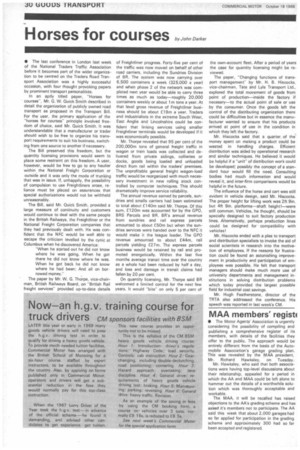Horses for courses
Page 32

If you've noticed an error in this article please click here to report it so we can fix it.
• The last conference in London last week of the National Traders Traffic Association before it becomes part of the wider organization to be centred on the Traders Road Transport Association was a highly successful occasion, with four thought provoking papers by prominent transport personalities.
In an aptly titled paper, "Horses for courses'', Mr. G. W. Quick Smith described in detail the organization of publicly owned road transport as proposed in the Transport Bill. For the user, the primary application of the "horses for courses" principle involved freedom of choice, said Mr. Quick Smith. It was understandable that a manufacturer or trader should wish to be free to organize his transport requirements to suit his business, switching from one source to another if necessary.
The Bill preserved this freedom, but the quantity licensing provisions would seem to place some restraint on this freedom. A user, however, would be free to go to any haulier within the National Freight Corporation or outside and it was only the mode of trunking that was in issue. If, unhappily, the possibility of compulsion to use Freightliners arose, reliance must be placed on assurances that special authorizations would not be withheld unreasonably.
The Bill, said Mr. Quick Smith, provided a large measure of continuity and customers would continue to deal with the same people in the British Railways, the Freightliner or the National Freight Corporation companies that they had previously dealt with. He was confident that the NFC would be well able to escape the criticism levelled by the cynic at Columbus when he discovered America: "When he started out he did not know where he was going. When he got there he did not know where he was. When he got back he did not know where he had been; And all on borrowed money."
The paper by Mr. W. G. Thorpe, vice-chairman, British Railways Board, on "British Rail freight services" provided up-to-date details of Freightliner progress. Forty-five per cent of the traffic was now moved on behalf of other road carriers, including the Sundries Division of BR. The system was now carrying over 6.500 containers a week (325,000 a year) and when phase 2 of the network was completed next year would be able to carry three times as much as today—roughly 20,000 containers weekly or about 1m tons a year. At that level gross revenue of Freightliner business should be about Cl 9m a year. Traders and industrialists in the extreme South West, East Anglia and Lincolnshire could be confident that linking services using smaller Freightliner terminals would be developed if it was economically possible.
Mr. Thorpe revealed that 95 per cent of the 200,000m tons of general freight traffic in wagon or train loads was collected and delivered from private sidings, collieries or docks, goods being loaded and unloaded direct from rail within the traders' premises. The unprofitable general freight wagon-load traffic would be reorganized with much necessary investment in new rolling stock controlled by computer techniques. This should dramatically improve service reliability.
The annual revenue earned by parcels, sundries and smalls carriers had been estimated to total about £140m said Mr. Thorpe. Of this sum, 120m was accounted for by the GPO, BRS Parcels and BR. BR's annual revenue from sundries and rail express parcels amounted to about £50m but when the sundries services were handed over to the NFC it would make it the league leader. The GPO revenue amounted to about £44m, rail parcels yielding £27m. The express parcels business would be retained by rail and promoted energetically. Within the last five months average transit time over the country as a whole had been reduced by half a day, and loss and damage in transit claims had fallen by 20 per cent.
On quantity licensing, Mr. Thorpe said BR welcomed a limited control for the next few years. It would "bite" on only 5 per cent of the own-account fleet. After a period of years the case for quantity licensing might be reviewed.
The paper, "Changing functions of transport management" by Mr. H. B. Hiscocks. vice-chairman, Tate and Lyle Transport Ltd., explored the total movement of goods from point of production—inside the factory if necesary—to the actual point of sale or use by the consumer. Once the goods left the control of the distributing organization there could be difficulties but in essence the manufacturer wanted to ensure that his products arrived at point of use in the condition in which they left the factory.
Mr. Hiscocks said that a quarter of the money spent on making a product could be wasted in handling charges. Efficient distribution was aided by operational research and similar techniques. He believed it would be helpful if a "unit" of distribution work could be developed; possibly the concept of a standard hour would fill the need. Consulting bodies had much information and would reveal it, and inter-firm comparisons would be helpful in the future.
The influence of the horse and cart was still evident in vehicle design, said Mr. Hiscocks. The proper height for lifting work was 2ft 9in. but 4ft 9in, platforms—shaft height!—were still common. Vehicles, he thought, should be specially designed to suit factory production lines. Alternatively, perhaps production lines could be designed for compatibility with vehicles I Mr. Hiscocks ended with a plea to transport and distribution specialists to invoke the aid of social scientists in research into the motivation of employees. If the reasons for frustration could be found an astonishing improvement in productivity and participation of employees was possible. He felt that transport managers should make much more use of university departments and management institutions in solving distribution problems which today provided the largest possible field for industrial cost savings.
Mr. Hugh Featherstone, director of the TRTA also addressed the conference. His speech was reported in last week's CM.
























































































































